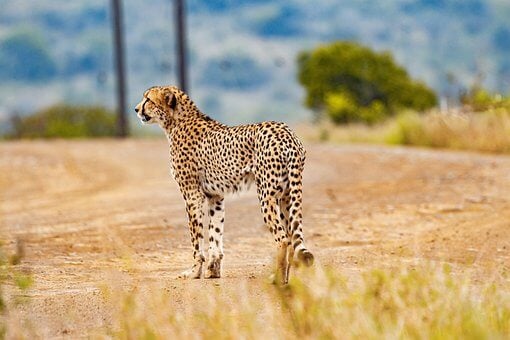In autumn 2022 and winter 2023, a total of 20 cheetahs from Namibia and South Africa were introduced to Kuno National Park in India to establish a free-ranging population – for the first time since their extinction in India 70 years ago.
Although the idea may be commendable, getting it right is not so easy. Scientists of the Cheetah Research Project of Leibniz-IZW in Namibia see shortcomings in the reintroduction plan: In southern Africa, cheetahs live in a stable socio-spatial system with widely spread territories and densities of less than one individual per 100 km². The plan for cheetahs in Kuno National Park assumes that the high prey density will sustain high cheetah densities, even though there is no evidence that high cheetah density depends on high prey density. As Kuno National Park is small, it is likely that the released animals will move far beyond the park’s boundaries and cause conflicts with neighbouring villages, the team said in a letter in the scientific journal “Conservation Science and Practice”.
The Asiatic cheetah (Acinonyx jubatus venaticus), a subspecies of the globally endangered cheetah, lived on the Indian subcontinent until it was driven extinct by people 70 years ago. In September 2022 and February 2023, a total of 20 cheetahs from Namibia and South Africa of the subspecies Acinonyx jubatus jubatus were introduced into Kuno National Park in the Indian state of Madhya Pradesh to act as the first nucleus of a new population of the cats in India. Kuno National Park is an unfenced wilderness area of approximately 17 by 44 kilometres (about 750 km²). Based on a calculation of the local prey density, it was calculated that 21 adult cheetahs could be sustained by the prey base in Kuno National Park – equivalent to a density of about three individuals per 100 km².
Based on their own research results from a long-term study of the spatial behaviour of cheetahs in Namibia, as well as comparable work in East Africa, scientists from the Leibniz Institute for Zoo and Wildlife Research (Leibniz-IZW) warn against overestimating the carrying capacity of the area. The carrying capacity is usually between 0.2 and 1 adult per 100 km² for cheetahs under natural conditions. This is true not only for Namibia, but also for the ecologically very different conditions in the Serengeti ecosystem in East Africa which has a much higher density of prey. Against this background, the team formulated predictions about the spatial behaviour of cheetahs in their new habitat, identifying controversial issues and hidden core assumptions of the reintroduction plan. These assumptions ignore important aspects of the cheetah socio-spatial system:
Male cheetahs follow two different spatial tactics. Territory holders occupy territories consisting of a collection of important communication hotspots. Males without territories (“floaters”) move and live between existing territories, as do females, with occasional forays into territories to access important information at marking sites. “The territories do not border each other, their centres are always about 20 to 23 kilometres apart,” says Dr Jörg Melzheimer from the Cheetah Research Project. “The space between the territories is not defended by any male, it is the living and transit space for floaters and females.” This deeply rooted behaviour will also lead to a system in India with territories about 20 to 23 kilometres apart. “This distance is independent of the actual size of the territories or the prey base,” adds Dr Bettina Wachter from the Cheetah Research Project. “In Namibia, territories are larger and prey density lower, in East Africa territories are smaller and prey density higher – but the distance between territories is a constant and no new territories are established in between. For the reintroduction plan in Kuno National Park, these distances were ignored.”
Already with the cheetahs transferred from Namibia in autumn 2022, including three males, the carrying capacity of Kuno National Park has been reached in terms of the cheetahs’ territorial system, Wachter, Melzheimer and their team conclude. “Regardless of the size of their territories established in India, the three Namibian males will have occupied the entire national park, leaving no room for further territories of the additional cheetahs recently transferred from South Africa,” they conclude. Although the process by which a socio-spatial system is established after a reintroduction has not yet been scientifically explored, there are initial findings that reintroduced cheetahs undertake long forays over an area of several thousand square kilometres in the first few months after translocation. “We therefore predict that cheetahs will most likely be also found far outside the national park and could come into conflict with farmers in the vicinity of the park,” the scientists write in their letter. The process of establishing their spatial system will probably take many months and will lead to the formation of territories outside the park, which is why the floaters and females will often be found outside the park as well.
In light of the present research findings, the team recommends that all future reintroductions of cheetahs in India take into account the spatial organisation of the species. This would permit to pro-actively address conflicts and provide valuable insights into the process of establishing cheetah territorial systems after reintroductions.
If our reporting has informed or inspired you, please consider making a donation. Every contribution, no matter the size, empowers us to continue delivering accurate, engaging, and trustworthy science and medical news. Independent journalism requires time, effort, and resources—your support ensures we can keep uncovering the stories that matter most to you.
Join us in making knowledge accessible and impactful. Thank you for standing with us!

